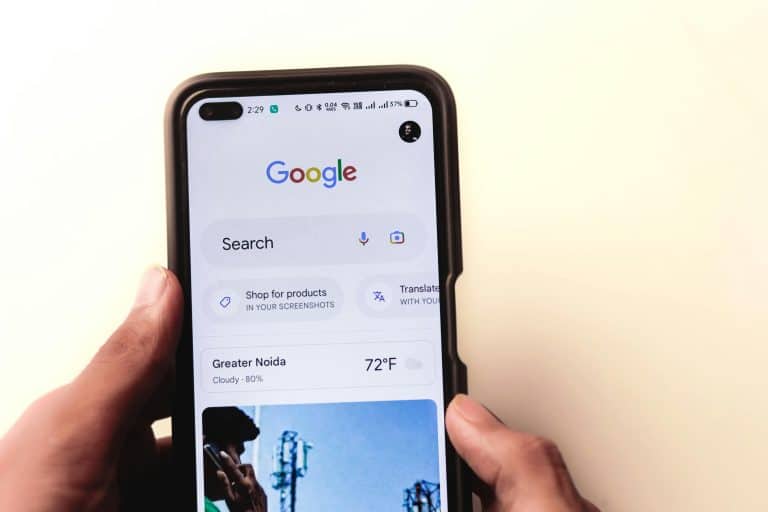What’s the point of a great website if no one can find it? For small businesses, an SEO-friendly website design is like putting a bright neon sign in the crowded world of Google search results. With 53.3% of all website traffic coming from organic searches, your site’s design is your secret weapon for better rankings and visibility.
Beyond search engines, SEO-friendly design enhances the user experience. Think faster load times, mobile-friendly pages, and content crafted for your audience—all of which keep visitors engaged and ready to buy. And here’s the kicker: SEO drives 1,000% more traffic than organic social media, making it essential for businesses aiming to grow.
In this article, we’ll break down what makes a website SEO-friendly and share practical tips to help your site get noticed, rank higher, and work harder for your business goals.
What Is an SEO-Friendly Website Design?
An SEO-friendly website design is like a finely-tuned machine that works seamlessly for both search engines and your visitors. It combines three essential elements:
- Technical optimization
- Content relevance
- User experience
Together, these ensure your site is easy to find, navigate, and rank on Google.
For small businesses, this kind of design goes beyond good looks—it’s a strategic asset. By focusing on clear structure, fast load times, and intuitive navigation, you’re creating a website that works as hard as you do to attract and retain customers.
For example, a mobile-friendly layout ensures your site looks great on any device, while features like schema markup help search engines understand your content. The result? A site that’s not only visually appealing but also highly functional, giving small businesses a competitive edge in the digital marketplace.
Core Elements of an SEO-Friendly Website Design
A truly SEO-friendly website balances technical functionality with user-centered design. Here are the core components every small business should focus on to ensure their site meets modern SEO standards:
Mobile Responsiveness
With more than half of global web traffic coming from mobile devices, having a responsive website design is non-negotiable. A mobile-friendly website adjusts seamlessly to different screen sizes, ensuring users can easily navigate your site on smartphones and tablets. Search engines prioritize mobile-friendly websites, so a responsive design directly impacts rankings.
Tips:
- Use a responsive web framework like Bootstrap.
- Test your site on multiple devices.
- Avoid pop-ups that disrupt the mobile experience.
Website Speed and Performance
Nobody likes a slow website—not users or search engines. Fast-loading websites improve user retention and directly influence rankings. Even a one-second delay can lead to a 7% drop in conversions, making speed optimization a critical element of SEO-friendly design.
Tips:
- Compress large images.
- Use caching plugins and Content Delivery Networks (CDNs).
- Test performance with tools like Google PageSpeed Insights or GTmetrix.
User-Friendly Navigation
Your website’s structure acts as a roadmap for both users and search engines. Intuitive menus and a clear sitemap make it easy for visitors to find what they need and for crawlers to index your content effectively.
Tips:
- Keep menus simple with clear labels.
- Create a structured XML sitemap for search engines.
- Use breadcrumbs to improve navigation.
Search-Focused Content
Content is the foundation of an SEO-friendly site. Crafting valuable, keyword-rich content tailored to your audience ensures relevance and engagement. When paired with metadata, internal links, and descriptive URLs, your content becomes a magnet for organic traffic.
By focusing on these core elements, small businesses can create a website that’s not just beautiful, but built to perform.

The Role of On-Page SEO in Website Design
On-page SEO is the backbone of any SEO-friendly website design. It ensures that every page is optimized for both search engines and users, acting as a roadmap to help your content get discovered, ranked, and clicked.
Meta Tags: The First Impression
Think of meta tags as the digital equivalent of a store window display—they entice your audience to step inside and explore what your website offers. A compelling title tag with primary keywords grabs attention, while a well-crafted meta description provides just enough detail to spark curiosity and drive clicks.
Example of a great meta tag in Google search:
- Title Tag: “SEO-Friendly Website Design | Boost Your Rankings & Traffic”
- Meta Description: “Learn how to create an SEO-friendly website with fast load times, mobile responsiveness, and optimized content. Perfect for small businesses!”
These simple yet powerful elements are your first chance to make an impression in search results. Use them wisely!
Headers and Alt Text: Organizing and Enhancing Content
Headers (H1, H2, etc.) structure your content, making it easier for both users and search engines to navigate. Pair these with optimized alt text for images to improve accessibility and provide additional keyword signals to search engines.
For example, instead of “image1.jpg,” use “mobile-responsive-website-design.jpg.”
Keywords: Seamlessly Integrated for Relevance
Think of keywords as the seasoning in a recipe—too little, and your content feels bland; too much, and it’s overwhelming. The perfect balance makes your website irresistible to both search engines and readers. Using primary and long-tail keywords naturally within your content is key to ranking without keyword stuffing.
For example, a real estate website targeting “luxury homes in Toronto” could use phrases like “Toronto luxury real estate listings” or “modern homes for sale in Toronto” to match what potential buyers are searching for.
The Power of Content in SEO-Friendly Website Design
Content is the foundation of an SEO-friendly website, acting as both a magnet for visitors and a signal for search engines. Here’s how quality content influences your website’s success:
Engaging Content Formats
High-quality content, such as blogs, videos, and landing pages, keeps users engaged and builds credibility.
- Blogs: Share actionable insights and relevant industry tips.
- Videos: Deliver compelling stories or product demos.
- Landing Pages: Highlight key services with tailored messaging.
Each format plays a role in attracting and retaining visitors while addressing their needs.
Relevance and Keyword Integration
Search engines prioritize content that meets user intent. By naturally incorporating primary and long-tail keywords, your pages rank higher and resonate with readers. For example, a blog post titled “Top Tips for Selling Your Home Faster in Toronto” could address common pain points while integrating target phrases seamlessly
Internal Linking for Navigation and SEO
Strategic internal links create pathways for users to explore your site, improving the user experience and helping search engines crawl your pages.
- Link blog posts to related service pages to guide visitors naturally.
- Use descriptive anchor text to clarify the link’s purpose.
By combining engaging formats, relevant content, and internal linking, your website becomes a hub for both users and search engines, driving traffic and boosting results.
Technical SEO Considerations for Website Design
Technical SEO ensures your website is functional, accessible, and optimized for search engines to understand and rank effectively. Here are three critical aspects every small business should focus on:
Secure Website (HTTPS)
A secure website is vital for protecting user data and building trust. Search engines like Google prioritize HTTPS websites in rankings, making SSL certificates a must-have for any business. Not only does it secure information, but it also signals professionalism to your audience.
Schema Markup and Structured Data
Schema markup acts as a translator, helping search engines understand your content better. For example, if your website is within the real estate industry, adding structured data to a real estate listing can highlight key details like price, location, and property type in search results. This enhanced visibility can attract more clicks and traffic to your website.
Crawlability and Indexability
If search engines can’t crawl and index your site, it’s like having a great storefront in the middle of nowhere. Use tools like XML sitemaps and robots.txt files to guide search engines through your pages. Ensure there are no broken links or dead ends that hinder discoverability.
By addressing these technical SEO considerations, your website becomes a well-oiled machine, primed for both search engines and users.
Tips for Small Businesses to Create SEO-Friendly Websites
Creating an SEO-friendly website doesn’t have to break the bank. Here are actionable tips tailored for small businesses:
- Leverage Affordable Tools: Platforms like WordPress and Wix offer user-friendly, budget-friendly solutions with built-in SEO features.
- Optimize for Mobile: Choose responsive templates to ensure your site looks great on all devices.
- Hire Professional Help: Consider professional web design services to get expert assistance with SEO, ensuring your website is optimized from the start.
- Update Content Regularly: Fresh, relevant content keeps visitors engaged and signals to search engines that your site is active.
- Monitor Analytics: Use free tools like Google Analytics to track traffic and identify areas for improvement.
- Focus on Local SEO: Optimize your site for local search with Google Business Profile and location-based keywords.
- Test Website Speed: Ensure fast loading times by compressing images and leveraging CDNs.
By following these tips, small businesses can build affordable, effective websites that perform well and attract more customers.
Conclusion
An SEO-friendly website design is more than just a tool for attracting traffic—it’s a long-term investment in your small business’s success. By optimizing your site for better rankings, faster load times, and seamless navigation, you can drive consistent traffic and conversions. Regular updates and maintenance ensure your website stays relevant, functional, and effective, keeping you ahead of the competition.
Ready to transform your brand with tailored design and content solutions? Let Pascual Creative bring your vision to life. Contact us today!



